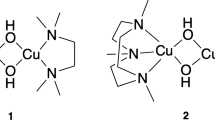Abstract
The electron-vibrational model for an organic dimer proposed in this paper allows one to take into account not only the electron correlation (the organic charge transfer complexes are strongly correlated systems) through the dimerized Hubbard model but also the internal structure of the dimer and each of its monomers by introducing an additional term into the Hamiltonian to describe the interaction between the electrons and the vibrational subsystem. Thus, it provides ample opportunities to minutely describe the polarization and conduction properties of organic dimer systems.
Similar content being viewed by others
References
Pool, Ch.P. and Owens, F.J., Introduction to Nanotechnology, Hoboken, NJ: Wiley, 2003.
Gusev, A.I., Nanomaterialy, nanostruktury, nanotekhnologii (Nanomaterials, Nanostructures, Nanotechnologies), Moscow: Fizmatlit, 2005.
Suzdalev, I.P., Nanotekhnologiya: fiziko-khimiya nanoklasterov, nanostruktur i nanomaterialov (Nanotechnology: Physicochemistry of Nanoclusters, Nanostructures and Nanomaterials), Moscow: KomKniga, 2006.
Martinez-Duart, J.M., Aqullo-Rueda, F., and Martin-Palma, R.J., Nanotechnology for Microelectronics and Optoelectronics, Amsterdam: Elsevier, 2006.
Kriger, Yu.G., Structural Instability of One-Dimensional. Systems as a Physical Principle Underlying the Functioning of Molecular Electronic Devices, Zh. Strukt. Khim., 1999, vol. 40, no. 4, pp. 734–766.
Pilot, R. and Bozio, R., Nonlinear Infrared and Optical Responses of a Holstein-Peirls-Hubbard Dimer, J. Phys. Chem., vol. 109, no. 41, pp. 19082–19089.
Jerome, D. and Schulz, H.J., Organic Conductors and Superconductors, Adv. Phys., 1982, vol. 31, no. 4, pp. 299–490.
Izyumov, Yu.A., Hubbard Model of Strong Correlations, Usp. Fiz. Nauk, 1995, vol. 165, no. 4, pp. 403–427.
Author information
Authors and Affiliations
Corresponding author
Additional information
Original Russian Text © O.V. Yaltychenko, E.Yu. Kanarovskii, 2011, published in Elektronnaya Obrabotka Materialov, 2011, No. 6, pp. 78–83.
About this article
Cite this article
Yaltychenko, O.V., Kanarovskii, E.Y. Electron-vibrational model for an organic dimer based on cation radicals TTF+ and anion radicals TCNQ− . Surf. Engin. Appl.Electrochem. 47, 549–554 (2011). https://doi.org/10.3103/S1068375511060202
Received:
Published:
Issue Date:
DOI: https://doi.org/10.3103/S1068375511060202




